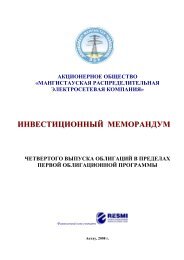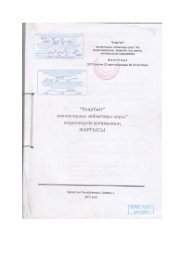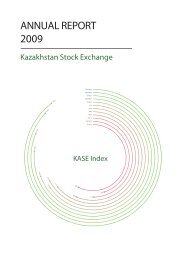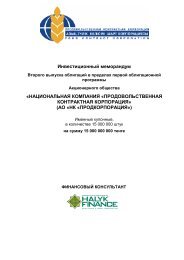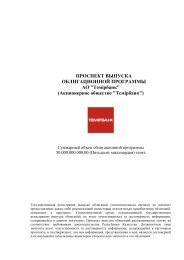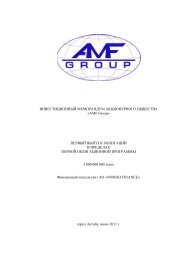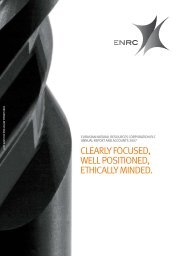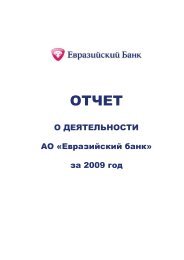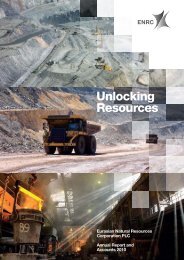JPMorgan - KASE
JPMorgan - KASE
JPMorgan - KASE
Create successful ePaper yourself
Turn your PDF publications into a flip-book with our unique Google optimized e-Paper software.
ended September 30, 2002, average production of 6,787 BOPD from this field was being trucked<br />
from eight wells to the Kumkol field. We have received all regulatory approvals for a 16-inch 177<br />
km pipeline, or the QAM pipeline, that will enable us to join both the Kumkol field and the QAM<br />
fields to a loading facility on the main rail link to both the Shymkent refinery and the export<br />
terminals on the Caspian Sea and the Black Sea. Orders for pipe and long lead equipment have<br />
been placed and we anticipate completion in the third quarter of 2003. This facility, which<br />
includes pumping stations and a rail loading system, will initially be capable of transporting<br />
140,000 BOPD. 3D seismic has been acquired over the whole field. Full field development is<br />
underway for a phased completion in the second quarter of 2003. We have a 100% interest in,<br />
and operate, the field. As of January 1, 2002, the Qyzylkiya field had estimated proved reserves<br />
of 20.6 MMbbls of crude oil.<br />
Aryskum Field. The Aryskum field was discovered in 1988. One productive zone in the<br />
Cretaceous formation was identified at a depth of less than 3,000 feet. As of September 30, 2002,<br />
eleven wells in which we have an interest had been drilled in this field. Initial production test<br />
rates for wells in the Aryskum field ranged from 50 to 600 BOPD per well. In the nine months<br />
ended September 30, 2002, average production was 3,227 BOPD. The proposed QAM pipeline<br />
referred to above with respect to the Qyzylkiya field is proposed to pass by this field. 3D seismic<br />
data have been acquired by us over the entire field. In addition, the construction of a road from<br />
the Aryskum field to the Qyzylkiya field was completed in 2001. As of January 1, 2002, the<br />
Aryskum field had estimated proved reserves of 9.9 MMbbls of crude oil.<br />
Maybulak Field. The Maybulak field was discovered in 1988 with four productive zones in the<br />
Jurassic formation identified at depths shallower than 6,000 feet. As of September 30, 2002,<br />
seven wells in which we have an interest had been drilled in this field. In the nine month ended<br />
September 30, 2002, average production was 878 BOPD. The proposed QAM pipeline referred to<br />
above with respect of the Qyzylkiya field is proposed to pass to the south of this field. In 2001,<br />
we conducted 3D seismic surveys over the entire area of the Maybulak field. Well tests and core<br />
studies have been completed and integrated into the development plans for this field. We have a<br />
100% interest in the field. As of January 1, 2002, the Maybulak field had estimated proved<br />
reserves of 11.9 MMbbls of crude oil.<br />
Nurali. The Nurali field was discovered in 1987. We have a 50% interest in the Nurali field<br />
through our interest in Kazgermunai. Delineation of this field began in 2001 with test production<br />
of certain wells and the acquisition of 3D seismic data. In the nine months ended September 30,<br />
2002, one Nurali well was on test production at a rate of 1,050 BOPD. In addition, 3D seismic<br />
surveys of the Nurali field was completed, which is now being interpreted for inclusion in the full<br />
field development plan due for submission to the Kazakhstan approval authorities. Kazgermunai<br />
satisfied the capital commitments under the licenses for the Nurali field in 2001. As of January 1,<br />
2002, the Nurali field had estimated proved reserves of 4.0 MMbbls of crude oil.<br />
Aksai. The Aksai field was discovered in 1988. We have a 50% interest in the Aksai field through<br />
our interest in Kazgermunai. Delineation of this field also began in 2001 with test production of<br />
certain wells and the acquisition of 3D seismic data. As of January 1, 2002, the Aksai field had<br />
estimated proved reserves of 2.1 MMbbls of crude oil.<br />
North Nurali. The North Nurali field was discovered in 2002 approximately 15 km west of the<br />
Kumkol field. This discovery has been validated by the drilling of two exploration wells in two<br />
separate leads in the area that we license in the South Turgai Basin. The first well, North Nurali 1,<br />
was drilled early in 2002 to a depth of 2,265 meters. With evidence of moveable light, 44 degree<br />
API, sweet crude, North Nurali 2 was immediately spudded in the neighboring lead just one<br />
kilometer to the east. North Nurali 2 has been drilled to a similar depth and seven potential oil<br />
bearing zones have been identified. Six zones have been tested under restricted conditions. The<br />
maximum rate obtained was 720 BOPD, however further testing will be conducted in 2003<br />
following fracture stimulation of the reservoir. Full delineation of North Nurali will be conducted<br />
in 2003 which includes the acquisition of 3D seismic.<br />
East Kumkol. The East Kumkol field was discovered in 2001 as a separate accumulation just east<br />
of the main Kumkol field and 7km from the CPF. Separate field status has been obtained from<br />
the approval authorities and permission was granted in 2001 for long-term well testing. There<br />
62




